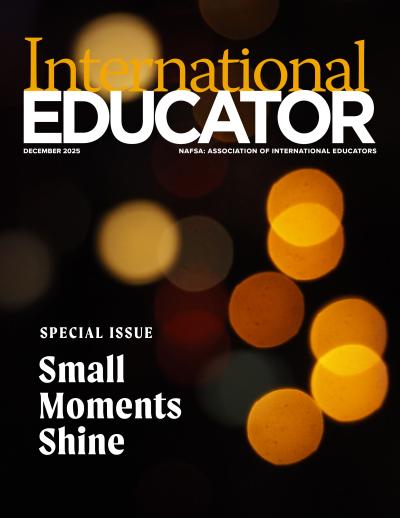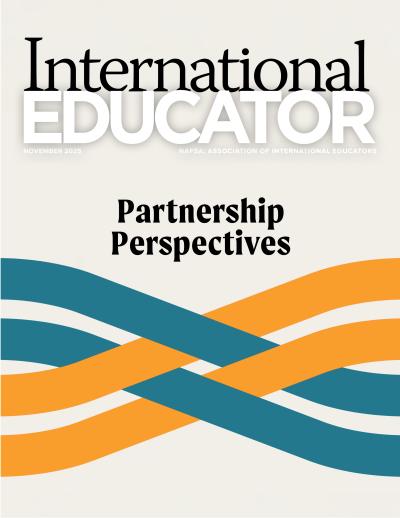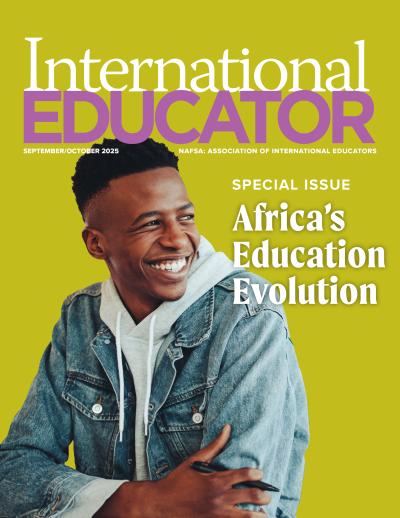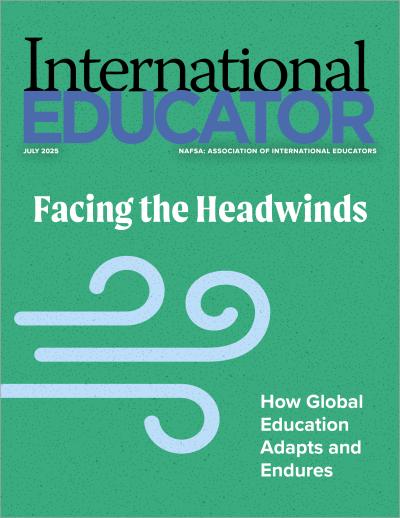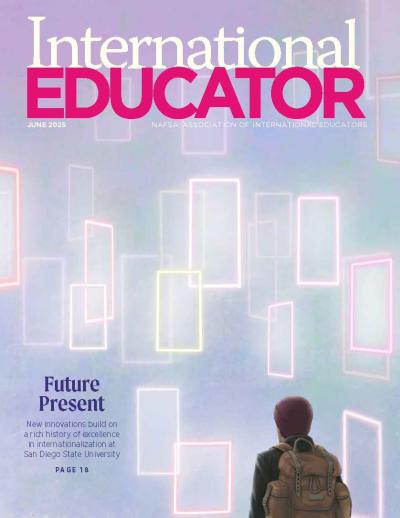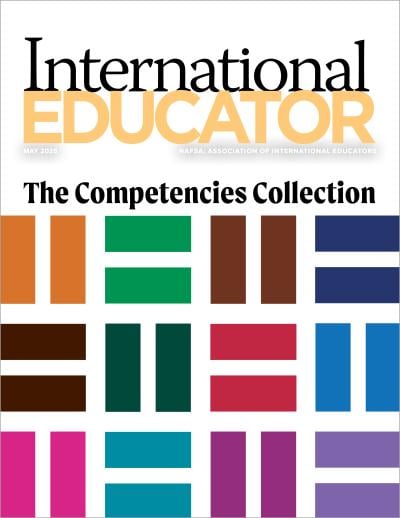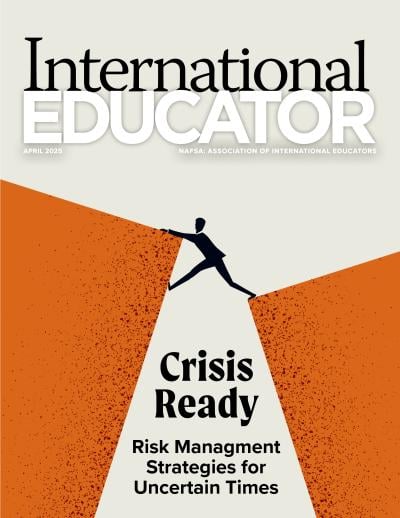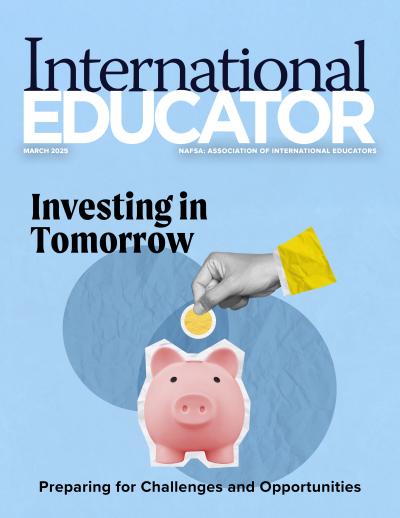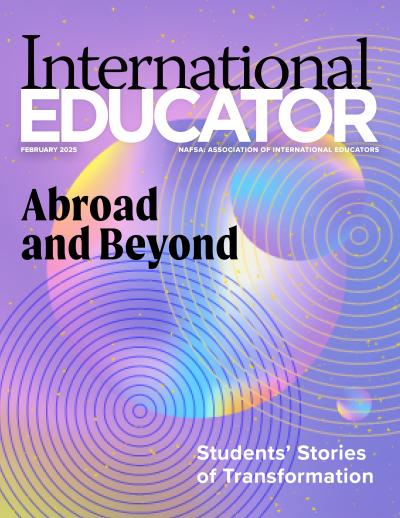Navigating Turbulent Times
Mariam Assefa remembers the first crisis she faced less than a year into her career: 1979's Iranian hostage crisis. "What was a very friendly nation turned into an adversary in a short period of time," says Assefa, who would later serve as NAFSA president and chair of the board of directors in 2006. "Immigration agents were asking us about students to a degree I had not witnessed before. And now we're talking about Iran again."
History may not repeat itself, as they say, but it often rhymes. The Iran hostage crisis, the Tiananmen Square protests, the Gulf War, September 11, 2001 (9/11), the so-called "Muslim ban," the COVID-19 pandemic, and now, the ever-changing posture of the second Trump administration—this is just a partial list of challenges the international education field has weathered over the past half century.
To understand how these experiences can offer guidance during a time of profound crisis for international education—and higher education as a whole—International Educator spoke to a half dozen leaders in the field whose collective careers span five decades. Each one spoke about the unique nature of today's challenges—and the importance of continuing to move the field forward regardless.
"Right now, the feeling is shell shock—people feel they can't move, can't say, can't do," says Adria Baker, founder and CEO of GlobalED Moments. "There are stages of grief, and we're in the middle of the beginning. We're going to have to move out of it."
Past Is Prologue
The history of NAFSA's 75-plus years of existence has been marked by crisis upon crisis. In fact, it was a challenge similar to 9/11 that ultimately led to the association's founding.
The bombing of Pearl Harbor in 1941—the first attack on U.S. soil since the War of 1812—brought together West Coast educators concerned about the plight of the more than 1,000 Japanese American college and university students on their campuses. It would take seven years, but those conversations culminated in the creation of NAFSA as an organization focused on supporting those who support international students.
Students wanted a safe haven, a place where they weren't treated with hostility. We protected our students, and the campus did as well. —Mariam Assefa
Suspicion of international students during times of crisis would echo through the decades that followed. The 1979 Iranian hostage crisis, for example, led to efforts by NAFSA and others to allow students to continue their studies. But that crisis introduced something new: calls by the federal government for enhanced tracking of international students, which would take on even greater significance in the decades that followed.
On campuses, international educators were fighting a more personal battle, one that would arise repeatedly in the subsequent decades. In each case, the response was the same.
"What we did as professionals working with international students was to snap into action," Assefa says. "Students wanted a safe haven, a place where they weren't treated with hostility. We protected our students, and the campus did as well."
The hostage crisis presented a complicating factor that would resurface in the future: when students from a country or region experiencing political turmoil represent a large portion of the total international student population. In 1979, Iranian students made up the largest proportion of international students in the United States. A decade later, this dynamic would recur when the 1989 Tiananmen Square protests unfolded. For the first time Chinese students had grown to represent more than half of all international students in the United States just before the events led to calls to protect them with deferred departures and work permits—calls which were ultimately heeded.
While the 9/11 attacks are viewed as a turning point in international affairs, their impact on international education was foreshadowed by the 1993 World Trade Center bombing in New York City, which renewed calls for greater regulation of international students. "Compliance became a big deal," Assefa recalls. "Many colleagues were saying their budgets were being eaten up by compliance."
A pilot data collection program called the Coordinated Interagency Partnership Regulating International Students (CIPRIS) launched in 1997, laying the foundation for the post-9/11 creation of the Student and Exchange Visitor Information System (SEVIS) in 2003. SEVIS came after several years of intensive advocacy by NAFSA and others in the field to maintain the flow of international exchange following the shock of the 9/11 attacks.
"Despite what looked like a huge setback for international education, eventually it did work out quite well," says Beatrice Camp, who served as chief of the educational information and resources branch of the U.S. State Department's Bureau of Educational and Cultural Affairs from 1999–2002 as part of a long career in the foreign service. "A system was put in place that has in fact worked well all these years since."
The experience of that turbulent time shaped the international education field into one that was flexible enough to handle the challenges that lay ahead. "How we navigated that is what helped us navigate...the pandemic and [the first Trump administration]," Baker says.
Flexibility and Focus
Flexibility and a focus on the big picture are critical skills for navigating today's challenges, says Heidi Gregori-Gahan, associate provost emerita of international programs and services at the University of Southern Indiana.
"I used to joke that even when we're pushing papers and issuing I-20s, we have to keep our eyes on the bigger picture," she says. "It's essential we keep that perspective, especially during moments of crisis. We have to stay hopeful and focused on the mission, especially for those individuals most affected."
Years of confronting successive crises have helped international educators develop essential strategies for navigating current challenges and uncertainty.
Earn students' trust.
Diana Carlin was just a year into being a senior international officer at the University of Kansas when the events of 9/11 unfolded. She immediately thought of the 250 students from Saudi Arabia—and many more from elsewhere in the Middle East—on campus. "Our first challenge was to make sure they were protected," she says. Staff fanned out and communicated with students, and families from the community offered places to stay for those who didn't feel comfortable remaining in residence halls.
Creating trust is particularly important today, given the current political climate and the reality that many students are staying in the country over breaks for fear of not being let back into the United States. "Double down on showing students all is not lost," Assefa says. "Our job as international educators is to treat students as students. Campus is still campus, our students are still our students, and we will protect [them]."
Focus on crisis management.
As a study abroad leader in the 1990s, DeDe Long worried about the wellbeing of students across the world. "You had the [Irish Republican Army] still active, bombs going off in London, trains exploding in Spain—significant but isolated experiences you couldn't predict," says Long, director emeritus at the University of Arkansas-Fayetteville. The advent of email and instantaneous communication both helped and exacerbated the challenge: "As soon as a mother could hear from their child five minutes after something happened anywhere in the world, that changed how [we reacted] to a crisis," she says.
Long and other international educators at the time did something that was new to the field: They developed crisis management plans. "We had to figure it out, and we didn't have an institutional history to draw from," she says.
These plans would evolve into a broader series of structures to communicate and respond in times of crisis. In her role at the State Department, Camp recalls how the 1996 deaths of five U.S. Semester at Sea students during a trip to India prompted universities across the country to establish 24/7 call centers and other supports for emergency situations.
In the years that followed, crisis management plans have helped Long and her staff navigate crises large and small—from drastic swings in exchange rates to health challenges such as severe acute respiratory syndrome (SARS) and the Zika virus. Regardless of the issue, the first step is to identify who is in harm's way and work backwards from there, according to Long.
"You've got to take the noise out of it," she says.
It's essential we keep that perspective, especially during moments of crisis. We have to stay hopeful and focused on the mission, especially for those individuals most affected. —Heidi Gregori-Gahan
Advocate for the field—but remember it's a marathon, not a sprint.
"One of the ways we have survived as a field is the strength of our government relations and advocacy," Carlin says. But history shows that this has never been an easy task.
Following 9/11, "NAFSA did a phenomenal job educating and building relationships with decision-makers and lawmakers," Baker says. However, that didn't happen overnight. She recalls the frosty reception she received when advocating with state legislators in Texas following 9/11 and hearing "all these perspectives we [had] never heard," she says.
However, persistence paid off: "We had a dialogue," Baker says. "It took us a while as international educators to learn what [legislators] needed and what their pain points were, but we did and were able to address them."
Small victories along the way mattered. Baker, Gregori-Gahan, and others ultimately persuaded lawmakers in their states to adopt resolutions affirming the value of international education. "There was no legal weight or funding attached, but the conversations leading up to them were important, and it was a huge win for us," Gregori-Gahan says.
With increased polarization and distrust, "our biggest problem today is that it's so hard to have our voices heard," Gregori-Gahan says. "But there are ways, and we have to keep working hard. The most effective way is sharing our students' stories. In the past, we [kept] telling the stories, and eventually [policymakers] heard the perspective. You can't give up."
"You've got to work with who you've got to work with," Carlin adds. "Make sure you keep the lines of communication open, understand where the problems are coming from, and provide information to at least educate and inform."
"Don't burn bridges," Long encourages. "Those relationships come back to save you time and time again."
Find new allies.
International educators need to identify supporters in their communities—and beyond them. "Alliances are crucial and have to be with people outside of our sphere," Carlin says.
Today, the business community—which like higher ed is facing extreme levels of uncertainty amid policy changes in trade and immigration—may be a key ally.
Carlin stresses the importance of creating structures for these kinds of conversations. She created an international advisory board, including not only business leaders from her region but also those from as far away as California, who relied on the international students her school educated. One benefit of this approach is that business leaders often conduct their own advocacy efforts, which can amplify common messages.
And remember "you're always an advocate," Long says. "It doesn't matter who you're talking to—students, parents, supervisors, congresspeople. If you're passionate about international education, you always have to keep in mind you [can] make a difference when you speak about the field."
Build community connections.
Gregori-Gahan always encouraged international students to speak to local K–12 schools and community organizations. "People got to see somebody, and when you have a face, it makes somebody human," she says.
That dichotomy has been brought into sharp relief with recent immigration actions. Assefa points to a New York Times article about a small Missouri town where a local diner employee and mother of three was deported, leading one resident to say, "no one voted to deport moms."
"When people get to know people, they act differently," she says. "The reality is that at the local level, there's a lot of support. At the end of the day, life happens on [campuses], and life happens in small communities. Good things happen on the ground."
In 2010, Gregori-Gahan hosted an Iraqi Young Leaders Exchange Program and worried about the reaction from the conservative Indiana community. For a month, the local newspaper followed students as they spoke in the community and visited host families. The result was "unbelievably rewarding," she says. "It was life changing for not just the students but also the campus and the community, all because someone put a human face on Iraq."
Be creative.
COVID-19 is an example of an impossible situation—internationalization at a time when mobility around the globe was impossible. "The field learned to pivot really quickly and became very creative," Baker says. As was the case then, "we're going to have to find new ways of teaching and creating community in ways we've never thought of before," she adds.
One key is leveraging existing assets when innovating. For example, international educators had explored virtual exchange—and used Zoom—before both became necessities during the pandemic. "It's really figuring out what we have at our disposal to provide international education in new ways to surmount some of the challenges," Carlin says.
Practice self-care—and encourage others to do the same.
"You have to step up, regroup, and take care of yourself and your staff," Baker says. "If [you don't], you're not helping anybody."
Supporting staff is particularly crucial. "People are just done," Long relays. Gregori-Gahan recalls how when her team of eight worked from home during the pandemic, they started checking in each morning via Zoom. "That sense of community is what we need as humans," she says.
I [was] thinking I'm going to help this next person. If I could do the best right thing for the next person and got through it, it took away the overwhelm. —Adria Baker
Collaborating with peers beyond campus through NAFSA and other organizations is critical. "It boils down to having a community of trust," Gregori-Gahan says. "It helps us find that voice of reason when we feel like we've lost focus. And a greater recognition of our shared humanity and what it means can result in deeper empathy—one of the essential skills we need in our work."
Focus on one person at a time.
Sometimes, the feeling of overwhelm is inescapable. Here again, the pandemic offers a guide for what may help now. "I [was] thinking I'm going to help this next person," Baker recalls of her mindset at the time. "If I could do the best right thing for the next person and got through it, it took away the overwhelm. Success was defined differently."
The Long Perspective
Carlin notes that the NAFSA 2025 Annual Conference & Expo in San Diego coincided with a one-two punch of bad news—an announced halt in visa interviews and a declaration that the Trump administration would seek to revoke the visas of Chinese students. Even so, she says, "people were still upbeat."
"You still send a message of hope and positivity," Carlin asserts.
And despite the noise and chaos, the power of international exchange endures, Camp says, noting that her next-door neighbor is currently hosting two Burmese students.
"Despite these setbacks, we have continued and prospered," she says. "Some of the adaptations we have had to make have been very difficult, sometimes almost impossible to surmount, and yet they have been surmounted. So I think the message is to adapt and continue working toward the goal."
Gregori-Gahan agrees. "Keeping that long perspective helps us to stay hopeful and focused. It's really important, because if we don't have that, it's going to trickle down to the people we serve," she says. "We can't let that happen." •
Adria Baker, Heidi Gregori-Gahan, and DeDe Long are each recipients of NAFSA's Life Membership award, in recognition of their decades of service in advancing the goals of the association and the field of international education.
NAFSA Resources
About International Educator
International Educator is NAFSA’s flagship publication and has been published continually since 1990. As a record of the association and the field of international education, IE includes articles on a variety of topics, trends, and issues facing NAFSA members and their work.
From in-depth features to interviews with thought leaders and columns tailored to NAFSA’s knowledge communities, IE provides must-read context and analysis to those working around the globe to advance international education and exchange.
About NAFSA
NAFSA: Association of International Educators is the world's largest nonprofit association dedicated to international education and exchange. NAFSA serves the needs of more than 10,000 members and international educators worldwide at more than 3,500 institutions, in over 150 countries.
NAFSA membership provides you with unmatched access to best-in-class programs, critical updates, and resources to professionalize your practice. Members gain unrivaled opportunities to partner with experienced international education leaders.





